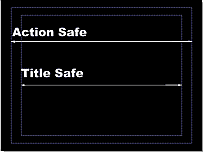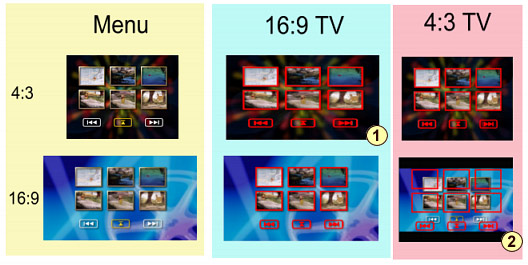
A Menu window is a place to create your Menu design, add buttons and to link them with other Menus or movies. In the real world, creating Menus and links is the main creative task of the DVD Authoring process and it determines how polished and professional the final DVD product will look.
Therefore DVD-lab put strong emphasis on this area of DVD creation. We can say with confidence that the Menu creation module of DVD-lab surpasses that of most any other DVD authoring tool.
The Menu window basics

Safe Area
We will refer to the working area of a Menu as a "canvas', it's shown in Black here. You will notice the two rectangles shown over the Menu canvas. This is called the "Safe Area".

Standard tube TVs are usually set to overscan, that means you can't see the edges and you lose up to 20% of the image that you would see on computer screen.
Make sure that all important information such as text and buttons are places within the Title Safe Area.
Zoom
You can zoom in or out of the Menu canvas by selecting a zoom in or zoom out tool and clicking on the Menu canvas where needed. Notice the zoom tools on the main toolbar:
![]()
Snap to Grid
The main toolbar has another Menu related button: Snap to Grid:

This will make designing layouts easier. Snap to Grid is a toggle, click the button to turn the feature on, click again to turn it off. The layout grid is set up in such a way that it follows a 4:3 ratio. With the Snap to Grid toggled on, it is very easy to move objects to line up in a precise manner.
Undo/Redo
The Menu window features multiple Undo/Redo (the number of undos can be set in the Project Properties).
![]()
The Undo/Redo feature keeps track of these object parameters: position, size, color, drop shadow, link.
![]() Basic design
Basic design
The Menu window features many controls and settings. On the right side of the window you have a Properties window with 4 Tabs: Color, Link, Map, PCG and Layers
On the left side is a toolbar with tools for creating text, rectangles, frames, Group Hotspot and chapter still image.
The top toolbar has settings for Navigational routing, simulation and buttons for moving in layers.
![]() Set the Background
Set the Background
You can supply your own image or use one of the DVD-lab supplied backgrounds.
In the Assets window, click the Backgrounds tab:

You will see a number of backgrounds available for your Menu. Pick one, Drag & Drop it onto the Menu. This will set the Background. You can replace the background with a different one at any time.
Tip: You can use a video still frame as a background when you drag the video frame from the Preview window onto the Menu while holding the SHIFT key. It's SHIFT-Drag & Drop. Similarly, you can use any image as a background if you drag it from Assets to Menu while holding the SHIFT key.
Merge to background
This command in the Menu will merge all objects in the menu onto the background. All links will be lost and all objects will be then deleted.
Guidelines
You can use guidelines to help you place your objects, as you might in many other graphic tools. To create a guideline, simply drag it from the horizontal or vertical ruler onto the canvas..

To remove guideline, drag it outside the canvas.
Objects will snap to the guidelines, if they are moved close to it. Guidelines are saved with the project.
By right-clicking on Ruler, you will open a Guidelines edit box where you can add or delete guidelines by their relative pixel numbers. This offers much precision by defining the exact screen pixel to align to.

DVD-lab allows you to create 16:9 aspect ratio Menus for viewing on a Widescreen TV.
However there is one important warning: Unlike the Multi-Aspect Menus found on commercial Hollywood DVDs and unlike a 4:3 Menu, the 16:9 Menu will only work properly on Widescreen TVs.

You can set 16:9 Menus in Properties.
The image below explains why 4:3 Menus are safest to use if you can't guarantee viewer will be watching your DVD on widescreen TV.
Shown here are the extreme cases. It also depends on the DVD player's ability and its user settings as how to treat 16:9 videos on a 4:3 TV.

The top row is designed as a 4:3 Menu and then displayed on Widescreen TV (1) and on Normal TV. On Widescreen TV, the Menu will be stretched, otherwise it will be aligned with the red subpicture. The bottom row is designed as a 16:9 Menu and then displayed on Widescreen TV and on Normal TV
(2). On the Widescreen TV it will look as we designed it, while on 4:3 the subpicture and the background will be not aligned. This is because the DVD player will letterbox the background but not the subpicture.
(The above is true if the DVD player is set to do letterboxing and not Pan & Scan on 16:9 materials, if set to Pan & Scan the result may be correct even on 4:3 TV)
While these are the extreme cases of what can go wrong, these examples clearly show that for a mixed audience the safest way is to use 4:3 Menus since the worst case is just stretched image (1). If you use the 16:9 Menus, the worst case would be a Menu mis-aligned with it's highlighted subpicture (2) but otherwise working.
Note: (1) Some DVD players can format the 4:3 Menus properly on Widescreen TV's without stretching.